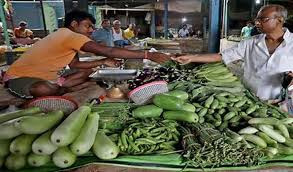“India’s Retail Inflation Hits 6.21% in October, Surpassing RBI’s Target”
India’s retail inflation surged to 6.21% in October 2024, up from 4.87% in the same month last year, breaching the Reserve Bank of India’s (RBI) tolerance limit. The rise in inflation was mainly driven by a sharp increase in vegetable prices, which saw an alarming rise of 42.18%, compared to October 2023.


India’s retail inflation surged to 6.21% in October 2024, up from 4.87% in the same month last year, breaching the Reserve Bank of India’s (RBI) tolerance limit. The rise in inflation was mainly driven by a sharp increase in vegetable prices, which saw an alarming rise of 42.18%, compared to October 2023.
The inflation rate in rural areas was higher at 6.68%, while urban areas recorded a slightly lower rate of 5.62%. This marks the second consecutive month of inflation exceeding the RBI’s targeted range of 4%, with a permissible deviation of 2% on either side.
Food Prices Contribute to the Surge
Food inflation for October 2024 stood at 10.87%, significantly higher than the 6.61% recorded in October 2023. The rise in food prices was primarily driven by the steep increase in vegetable costs. Vegetable prices alone accounted for the highest inflation among all food categories, with a staggering 42.18% rise. Urban areas experienced a marginally higher increase at 42.63%, compared to 41.94% in rural areas.
Other food items also saw notable price hikes. Oils and fats experienced a rise of 9.51%, while fruits saw a 8.43% increase. On the other hand, spices saw a decline of 7.01% in prices.
Impact Across Different States
The rise in inflation varied across the country. Chhattisgarh reported the highest inflation at 8.84%, followed by Bihar at 7.83% and Odisha at 7.51%. On the other hand, Delhi had the lowest inflation rate at 4.01%, followed by West Bengal at 4.63% and Maharashtra at 5.38%.
RBI’s Inflation Target Under Scrutiny
The RBI’s inflation target for India remains at 4%, with a 2% margin on either side, meaning inflation should ideally fall between 2% and 6%. However, the October figures exceeded this range, raising concerns about the central bank’s ability to bring inflation under control.
Despite the inflation exceeding the target, the RBI decided to keep the repo rate unchanged at 6.5% in its most recent monetary policy meeting, signaling that the central bank is cautious about further rate hikes in the face of rising food prices.
Looking Ahead
With vegetable prices continuing to rise sharply, the government and the RBI will likely face pressure to address inflationary trends, especially as it affects household budgets across the country. The surge in food inflation, particularly in rural and urban areas, could have broader economic implications, potentially impacting consumer spending and economic growth.
Experts predict that food inflation could stabilize once the supply chains are restored, and as harvest seasons progress, but for now, the retail inflation rate remains a concern for policymakers and consumers alike.
Sources By Agencies








Noodlemagazine You’re so awesome! I don’t believe I have read a single thing like that before. So great to find someone with some original thoughts on this topic. Really.. thank you for starting this up. This website is something that is needed on the internet, someone with a little originality!
Mat6tube I’m not even sure how I got here, but I thought this post was fantastic
FlixHQ You’re terrific! I don’t believe I’ve encountered anything similar before. It’s great to find someone with unique thoughts on this subject. Thank you for creating this. The internet needs more sites like this one – original and fresh!